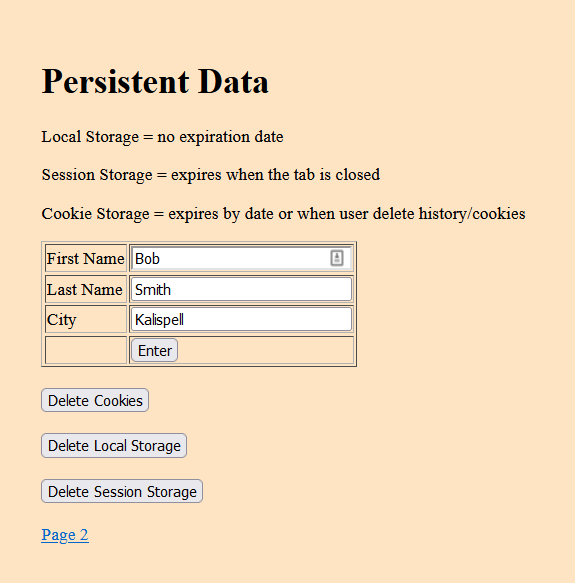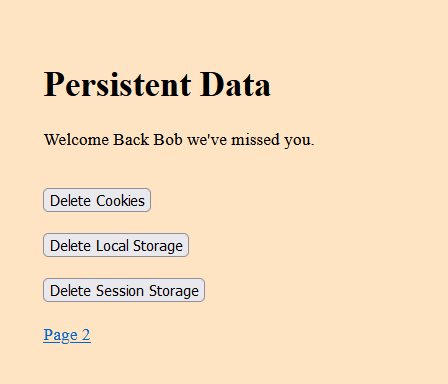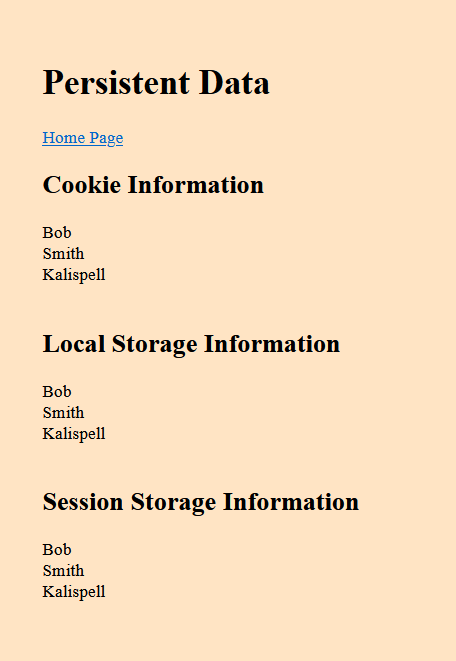Storing Web Data#
All three, cookies, local storage, and session storage, are mechanisms for storing data related to web browsing. They differ in where the data is stored, persistence, accessibility, and use cases.
Cookies:
Storage: On the user’s device (client-side)
Persistence: Varies. Cookies can have an expiration date set by the server or persist until manually cleared by the user.
Accessibility: Accessible by both the client (browser) and the server (website). When a browser requests a web page from a server that previously sent a cookie, the browser includes the cookie in the request.
Use cases: - Remembering user preferences (e.g., language) - Session management (e.g., shopping cart contents) - Tracking user behavior (e.g., analytics)
Local Storage:
Storage: On the user’s device (client-side)
Persistence: Persistent until manually cleared by the user or until storage quota is reached.
Accessibility: Accessible only by the client (browser) for the specific website that created it. Isolated from other websites and server-side scripts.
Use cases: - Storing user preferences (e.g., location) - Application data (e.g., to-do list items)
Session Storage:
Storage: On the user’s device (client-side)
Persistence: Temporary. Data is cleared when the browser tab or window is closed.
Accessibility: Accessible only by the client (browser) for the specific website and tab/window that created it.
Use cases: - Caching temporary data (e.g., form input during multi-step process)
Here’s a table summarizing the key differences:
Feature |
Cookies |
Local Storage |
Session Storage |
|---|---|---|---|
Storage |
Client-side |
Client-side |
Client-side |
Persistence |
Varies |
Persistent |
Session only |
Accessibility |
Client & Server |
Client only |
Client only |
Use cases |
Preferences, Session |
Preferences, App data |
Temporary data |
Lecture Code#
index.html Explanation#
This code snippet appears to be an HTML form that demonstrates the usage of cookies, local storage, and session storage. Here’s a breakdown of the code:
HTML Structure:
The code defines a basic HTML page with a form and buttons.
The form has fields for first name, last name, and city.
There are buttons to delete cookies, local storage, and session storage.
There’s also a link to a second page (“Page 2”).
JavaScript Functions:
validateForm():
This function is called when the form is submitted.
It retrieves the values from the form fields for first name, last name, and city.
It calls the
setCookiefunction to store these values in cookies with an expiry time of 20 days.It uses
localStorage.setItemto store the values in local storage (no expiry).It uses
sessionStorage.setItemto store the values in session storage (expires when the tab closes).The function returns true, allowing the form submission to proceed.
deleteCookies():
This function calls the
deleteCookiefunction (cookiefunctions.js`) to delete the cookies named “firstName”, “lastName”, and “city”.
deleteLocalStorage():
This function uses
localStorage.clear()to remove all items from local storage. (Alternatively, it could uselocalStorage.removeItemto target specific items).
deleteSessionStorage():
This function uses
sessionStorage.clear()to remove all items from session storage. (Alternatively, it could usesessionStorage.removeItemto target specific items).
Overall Functionality:
When the user enters their information and submits the form, the data is stored in cookies (with expiry), local storage (no expiry), and session storage (expires with the tab).
The buttons allow the user to delete the stored data from cookies, local storage, or session storage independently.
There’s a link to a second page (“Page 2”) but it’s unclear how this page might interact with the stored data.
This code provides a basic example of using these data storage mechanisms in a web page. In a real application, you’d likely want to consider the appropriate storage method based on the type of data and how long you need it to persist.


<!DOCTYPE html>
<html lang="en">
<head>
<meta charset="utf-8">
<meta name="viewport" content="width=device-width, initial-scale=1">
<title>Page 1</title>
<script src="cookiefunctions.js" type="text/javascript"></script>
<style>
.theContent {
width: 40%;
margin: 100px auto;
background-color: bisque;
padding: 40px;
color: black;
}
</style>
<script>
function validateForm() {
let xfname, xlname, xcity;
xfname = document.getElementById("fname").value;
xlname = document.getElementById("lname").value;
xcity = document.getElementById("city").value;
// set cookies - expires by time
setCookie("firstName", xfname, 20);
setCookie("lastName", xlname, 20);
setCookie("city", xcity, 20);
// set localstorage - no expiration date
localStorage.setItem("firstName", xfname);
localStorage.setItem("lastName", xlname);
localStorage.setItem("city", xcity);
// set set session storage
sessionStorage.setItem("firstName", xfname);
sessionStorage.setItem("lastName", xlname);
sessionStorage.setItem("city", xcity);
return true;
}
function deleteCookies() {
deleteCookie("firstName");
deleteCookie("lastName");
deleteCookie("city");
}
function deleteLocalStorage() {
// clear them all
localStorage.clear();
// delete one item;
//localStorage.removeItem("firstName");
}
function deleteSessionStorage() {
sessionStorage.clear();
// delete one
// sessionStorage.removeItem("firstName");
}
</script>
</head>
<body>
<div class="theContent">
<h1>Persistent Data</h1>
<div id="Welcome">
<p id="p1"></p>
</div>
<div id="EnterName">
<p>Local Storage = no expiration date</p>
<p>Session Storage = expires when the tab is closed</p>
<p>Cookie Storage = expires by date or when user delete history/cookies</p>
<form onsubmit="return validateForm()" action="">
<table border="1">
<tr>
<td><label for="fname">First Name</label></td>
<td><input type="text" name="fname" id="fname"
value="Bob" size="25"></td>
</tr>
<tr>
<td><label for="lname">Last Name</label></td>
<td><input type="text" name="lname" id="lname"
value="Smith" size="25"></td>
</tr>
<tr>
<td><label for="city">City</label></td>
<td><input type="text" name="city" id="city"
value="Kalispell" size="25"></td>
</tr>
<tr>
<td></td>
<td><input type="submit" value="Enter" size="25"></td>
</tr>
</table>
</form>
</div>
<br>
<button onclick="deleteCookies()">Delete Cookies</button><br><br>
<button onclick="deleteLocalStorage()">Delete Local Storage</button><br><br>
<button onclick="deleteSessionStorage()">Delete Session Storage</button><br><br>
<a href="page2.html">Page 2</a>
</div>
</body>
</html>
page2.html Explanation#
The second page (“Page 2”) of the same website. This page focuses on displaying the information stored in cookies, local storage, and session storage.
Here’s a breakdown of the code:
HTML Structure:
The structure is similar to the previous page with a “theContent” class for styling.
It has a link back to the homepage (“index.html”).
There are sections for “Cookie Information,” “Local Storage Information,” and “Session Storage Information”.
Each section has empty spans with IDs for displaying retrieved data.
JavaScript:
The code retrieves the values from cookies, local storage, and session storage using the same functions (
getCookie,localStorage.getItem, andsessionStorage.getItem) as in the previous page.It then finds the corresponding span elements using their IDs and sets their innerHTML content to the retrieved values.
Overall Functionality:
This page retrieves the data previously stored on the first page and displays it in separate sections for cookies, local storage, and session storage.
This allows the user to see what information is stored using each mechanism.
In essence, this code demonstrates how to access and display data stored on the previous page (“Page 1”) using cookies, local storage, and session storage.

<!DOCTYPE html>
<html lang="en">
<head>
<meta charset="utf-8">
<meta name="viewport" content="width=device-width, initial-scale=1">
<title>Page 2</title>
<script src="cookiefunctions.js" type="text/javascript"></script>
<style>
.theContent {
width: 40%;
margin: 100px auto;
background-color: bisque;
padding: 40px;
color: black;
}
</style>
</head>
<body>
<div class="theContent">
<h1>Persistent Data</h1>
<a href="index.html">Home Page</a>
<h2>Cookie Information</h2>
<span id="cspanfn"></span><br>
<span id="cspanln"></span><br>
<span id="cspancity"></span><br><br>
<h2>Local Storage Information</h2>
<span id="lspanfn"></span><br>
<span id="lspanln"></span><br>
<span id="lspancity"></span><br><br>
<h2>Session Storage Information</h2>
<span id="sspanfn"></span><br>
<span id="sspanln"></span><br>
<span id="sspancity"></span><br><br>
</div>
<script>
document.getElementById("cspanfn").innerHTML = getCookie("firstName");
document.getElementById("cspanln").innerHTML = getCookie("lastName");
document.getElementById("cspancity").innerHTML = getCookie("city");
document.getElementById("lspanfn").innerHTML =
localStorage.getItem("firstName");
document.getElementById("lspanln").innerHTML =
localStorage.getItem("lastName");
document.getElementById("lspancity").innerHTML =
localStorage.getItem("city");
document.getElementById("sspanfn").innerHTML =
sessionStorage.getItem("firstName");
document.getElementById("sspanln").innerHTML =
sessionStorage.getItem("lastName");
document.getElementById("sspancity").innerHTML =
sessionStorage.getItem("city");
</script>
</body>
</html>